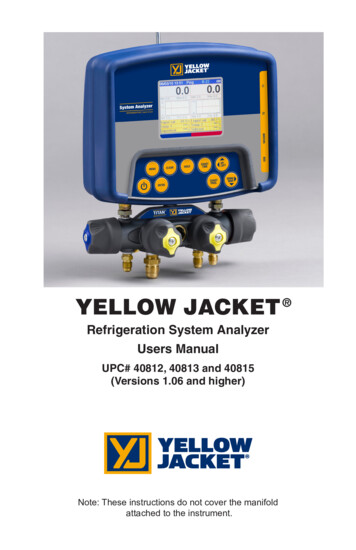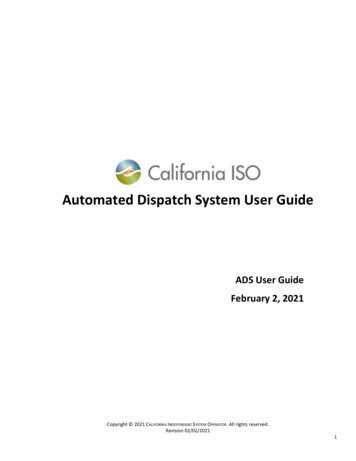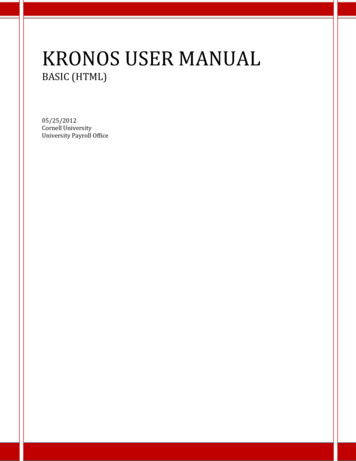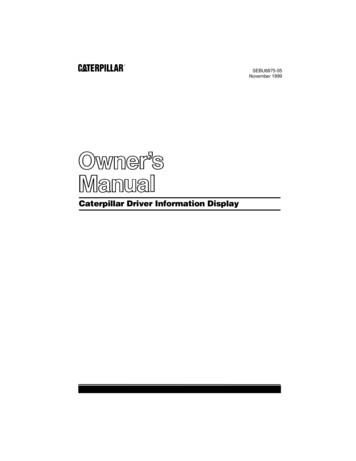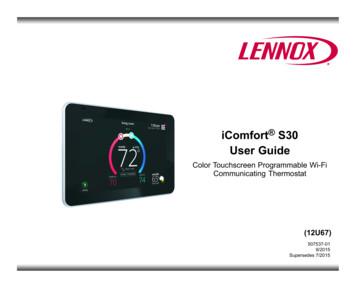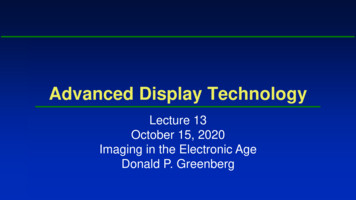
Transcription
Advanced Display TechnologyLecture 13October 15, 2020Imaging in the Electronic AgeDonald P. Greenberg
Liquid Crystal Color DisplayScientific American, November 1997
How can we extend this technology to color?
3-Chip DLP Color Optical System
DLP Projection System
Digital Micromirror Devices (DMD) Pioneered by Texas Instruments. The research on these micromechanical(MEMs) devices started in 1977. The first digital light valve projection systems (DLPs) had mirrors measuring17 microns per side. At 1280 x 1028 resolution (HDTV) this resulted in arather large chip in 1996. Today this technology is used in almost all digital theaters and some hometelevisions. Most theaters now use DLP with 4K resolution (4096 x 2160)
Christie CP4230 Digital Cinema Projector 4K DLPScreen size up to 105ft (32m)4096 x 2160 resolution2100:1 contrast
Cost of HDTV DisplaysPlasmaPrice ProjectionTV’sLCD’sDiagonal Inches
Cost of HDTV DisplaysPlasmaPrice ProjectionTV’sLCD’sNote: Each year thecross over pointskeep moving to theright.Diagonal Inches
Smart Headlight
Headlights- Carnegie Mellon
Modifications to Existing Technology The quest for energy reduction
How E-Paper WorksLIGHT STATEGYRICON BEADSDARK STATEELECTRODEScientific American, 11/2001, p. 54.
Electronic Reusable PaperThe paper pulp of the future.http://www2.parc.com/hsl/projects/gyricon/
Nick Sheridon, Xerox PARC inventor of electronic reusable paper, andFereshteh Lesani show off the first roll produced by 3M /
How E-Paper WorksGYRICON BEADSLIGHT STATEDARK STATEELECTRODEE INK MICROCAPSULESLIGHT STATEDARK STATENEGATIVELYCHARGEDPOSTIVELYCHARGEDScientific American, 11/2001, p. 54.
Flexible Electronic Paper DisplayElectronic ink is a straightforward fusion of chemistry,physics and electronics to create this new .html
E-InkMIT, Late 1990’sFlexible Tablet-Sized Display FromL.G. PhilipsLCD and E Ink Corporationhttp://www.eink.com/
Plastic Logic2000
Kindle dle-paperwhite-2019-and-kindle-2019/
The XO and One Laptop Per ChildThe custom XO display contains a reflectivelayer between it’s backlight and the speciallyformatted LCD layer, allowing it to turn highambient lighting conditions to it’s advantage.The display is not only inexpensive ( 30/unit),but is also much easier on the eyes.2005
Images Through Screen Doors
Pixel Qi
Pixel Qi2008
E-PaperThe Quest for Color
E-paper Technology2019Spectral displays are made ofmillions of Microcapsules whichsuspend the pigments in clearfluid.
E-paper Technology2019
E-paper Technology2019
Organic LEDs (OLEDs)2007SOFT LIGHT: Junji Kido ofYamagata University shows off hisbright and smooth prototype OLEDsystem.John Boyd. “Let There Be (a New Kind of) Light,” IEEE Spectrum, July 2007.
Organic LEDs (OLEDs) Composed of a thin film of organic compounds andconductive layers sandwiched between two electrodes When the charges recombine in the organic layer, energyis released in the form of photons Can be made with fluorescent-based or phosphorescentmaterialJohn Boyd. “Let There Be (a New Kind of) Light,” IEEE Spectrum, July 2007.
Organic LEDs (OLEDs) Advantages In theory, the energy of this conversion could reach 100% Thickness can be measured in nanometers (extremely thin and lightweight)excluding the substrate Can be manufactured in sheet form Can be put on a variety of substrates including flexible plastic Material is environmentally friendly (no harmful elements)John Boyd. “Let There Be (a New Kind of) Light,” IEEE Spectrum, July 2007.
Potential Uses Could be applied as wallpaper for illumination purposes Very bright and can replace light bulbs – already 4x more efficient thanlight bulbs in terms of lumens/watt With ability to produce red, green, and blue (new), can be used for displaysJohn Boyd. “Let There Be (a New Kind of) Light,” IEEE Spectrum, July 2007.
OLED schematic1. Cathode (-), 2. Emissive Layer, 3. Emission of radiation, 4 . Conductive Layer, 5. Anode ( )http://en.wikipedia.org/wiki/Organic light-emitting diode#Working principle
OLED ExplanationA. A voltage is applied across the OLED such that the anode is positive withrespect to the cathode. Electrons flow from cathode to anode.B. Thus the cathode gives electrons to the emissive layer and the anodewithdraws electrons from the conductive layer (causing electron holes).
OLED ExplanationC. Electrostatic forces bring the electrons and holes together and theyrecombine.D. In organic semiconductors, holes are more mobile than electrons. Thishappens closer to the emissive layer.E. The recombination causes an emission of radiation whose frequency is in thevisible region.
Sony 11-inch OLED Panel2007
Sony 27-inch OLED Panel2007
Modifications to Existing Technology The quest for energy reduction The quest for size
Cornell Panoramic Projection System
NASA Ames Control RoomFutureFlight Center at NASA-Ames
Stonybrook’s Reality Deck
Stony Brook’s Reality Deck
Samsung model S9 4K OLED TV, 98” behemoth 2013
Samsung 110-inch 4K UHD TV2014
Samsung Curved OLED TV55 inches
LG UHD Display88’2019
Crystal LEDSONY 202016 ft, 8K9 and-packs-16kresolution/ 877,0004K
Foldable Phones2019
Foldable Laptops2019
OLED TV RX
Flexible Displays
LG press-on 'wallpaper' TV under 1mm thick
Modifications to Existing Technology The quest for energy reduction The quest for size The quest for brightness
Visual Adaptationdisplaysluminance(log cd/m2)-6-4starlightrange ofillumination-20moonlightscotopic poor contrast no color low acuitymesopic2indoor lighting46sunlightphotopic good contrast good color high acuity8
Sunnybrook Display TechnologyHigh resolutioncolour LCDHigh Dynamic RangeDisplayLow resolutionIndividually ModulatedLED array
4K Ultra HDLG 20203840 x 2160 Pixels
Quantum Dots
Quantum Dots QD’s can generate spectrally narrow primaries Color can be easily controlled by quantum dot size QD technology is more cost-effective than OLED’s
Color Control by QD Particle Size
Quantum Dot ManufactureNanosys/3M
Quantum Dot Advantages Saves watts as almost all energy is converted into lightQD’s are very small (1.5nm (violet) 5.0nm (red)) allowingVery high resolution (ppi)QD’s can support large flexible displaysQD’s offer high brightness (50-100x) LED’s
Quantum Dot BacklightingLCDQuantum Dots used to create even white Backlighting Light passes through RGB filters.QDEF LCDQuantum Dots use a Blue LED and the Blue quantum dots to energize the red and greenphosphors.QD LEDLight from the Blue quantum dots pass directly through the black sub-pixels toilluminate the display.
Samsung Quantum Dot Display2017
Modifications to Existing Technology The quest for energy reduction The quest for size The quest for brightness The quest for larger gamut
Color Gamut Comparison2019
Color Gamut2020
Modifications to Existing Technology The quest for energy reduction The quest for size The quest for brightness The quest for larger gamut The quest for resolution
Retinal Displays1. Drive electronicsSource image4. Viewing optics3. Horizontal & vertical scanners2. Modulated light sourcesVirtual Retinal Display primary components.
This schematic diagram illustrates the functional components of a laserscanned display system.Information Display, “A Helmet-Mounted Laser Display,” January 2000, vol. 16, no. 1, p. 13.
End
Liquid Crystal Display (LCD)
QDEF LCDBlue Quantum Dotsare used as backlights
QD LCDBlue Quantum Dots areused to energize the redand green phosphors andthe blue QD lightbecomes the blue subpixel
Very bright and can replace light bulbs –already 4x more efficient than light bulbs in terms of lumens/watt With ability to produce red, green, and blue (new), can be used for displays John Boyd. “Let There Be (a New Ki

